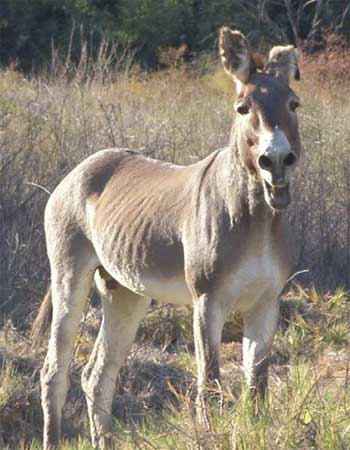MAY 13, 2015
Unchecked burro population growth damaging habitats
 BULLHEAD CITY, Ariz. — An alarmingly large and rapidly expanding burro population is damaging wildlife habitat, crowding out wildlife species and incurring costs to state and federal taxpayers, according to testimony at the May meeting of the Arizona Game and Fish Commission in Bullhead City.
BULLHEAD CITY, Ariz. — An alarmingly large and rapidly expanding burro population is damaging wildlife habitat, crowding out wildlife species and incurring costs to state and federal taxpayers, according to testimony at the May meeting of the Arizona Game and Fish Commission in Bullhead City.
In addition to the animal’s impact to other species and habitats, Arizona residents are also being impacted by an over-abundance of burros, said Bullhead City Mayor Tom Brady.
“This is a significant issue that is having a direct impact on our community – and others around the state – and must be resolved,” Mayor Brady said. “Due to a lack of proper management, the population of burros is now expanding at an alarming rate and is creating a public safety and ecological concern for our residents.”
Burros are negatively affecting habitat relied upon by bighorn sheep, mule deer, Gambel’s quail, sensitive migratory songbirds and other wildlife species that have evolved to live in the desert. While desert wildlife species consume only parts of plants that easily grow back, burros also eat the bark and even remove whole limbs from trees, often leaving only stumps. They consume native grasses down to the roots, preventing them from growing back, muddy waterholes used by other wildlife and disturb sensitive nesting grounds. In some cases, where the habitat damage is severe and long term, wildlife are being displaced from their home territories.
In the Black Mountains between Kingman and Bullhead City, for example, Bureau of Land Management (BLM) resource management plans call for a maximum population of 478 burros, but the area currently has between 1,746 and 1,827 burros – almost four times the allowable limit. Other parts of the state have burro populations more than nine times “appropriate management levels” established by Congress and administered by the BLM.
“We are now in a position where an over-abundance of a single, non-native, feral species now outnumbers our native iconic bighorn sheep in the Black Mountains,” said Commission Chairman Robert Mansell. “Burros are having a negative impact on our fragile desert ecosystems, competing with sensitive wildlife species for forage and water, and are destroying desert vegetation. As the agency responsible for conserving Arizona’s wildlife, that’s very concerning and indicative of a larger problem that must be addressed.”
State agencies such as Game and Fish are federally prohibited from managing burro populations. The BLM is required by the 1971 Wild Free-Roaming Horse and Burro Act to maintain appropriate numbers of burros, but local/regional burro management efforts have been hampered by a lack of funding and support from Congress and senior federal leaders.
The Department will continue collecting and analyzing data on burro impacts to wildlife and their habitats, and desires to cooperate with the BLM to reduce burro populations. The department also is engaging stakeholders and other partners to identify more effective burro management approaches that provide for wildlife habitat needs, while seeking congressional support to require the Department of Interior to comply with “appropriate management levels.”



